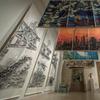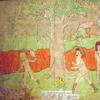Modern Couples: Art, Intimacy and the Avant-garde
- LONDON, United Kingdom
- /
- October 15, 2018
In London, Barbican Art Gallery’s pioneering autumn exhibition Modern Couples: Art, Intimacy and the Avant-garde showcases the creative output of over 40 artist couples active in the first half of the 20th century. Drawing on loans from private and public collections worldwide, this major interdisciplinary show features the work of painters, sculptors, photographers, architects, designers, writers, musicians and performers, shown alongside personal photographs, love letters, gifts and rare archival material. Among the highlights are legendary duos such as: Jean Arp and Sophie Taeuber-Arp; Camille Claudel and Auguste Rodin; Barbara Hepworth and Ben Nicholson; Frida Kahloand Diego Rivera; Dora Maar and Pablo Picasso; Lee Miller and Man Ray; Varvara Stepanova and Alexander Rodchenko; Virginia Woolf and Vita Sackville-West; as well as lesser known pairings such as Emilie Flöge and Gustav Klimt, Federico García Lorca and Salvador Dalí, Romaine Brooks and Natalie Clifford-Barney and Lavinia Schulz and Walter Holdt.
On view now through January 27, 2019, Modern Couples is part of the Barbican Centre’s The Art of Change, a yearlong season that explores the relationship between art, society and politics. By focusing on intimate relationships in all their forms – obsessional, conventional, mythic, platonic, fleeting, life-long – it also reveals the way in which creative individuals came together, transgressing the constraints of their time, reshaping art, redefining gender stereotypes and forging news ways of living and loving. Importantly, the exhibition also challenges the idea that the history of art was a singular line of solitary, predominantly male geniuses.
Jane Alison, Head of Visual Arts, Barbican, said: “This is such an extraordinary project as it brings together many of the most exciting figures of the avant-garde period, while setting up fascinating juxtapositions and taking visitors on a journey of discovery. Its new take on modern art history, focusing on collaboration and mutual influence in intimate relationships, could not be timelier. The show offers visitors a deeply personal and revealing insight into the transformative impact artists’ had on each other. Ultimately it is an exhibition about modern art and modern love.”
Carefully choreographed as a journey through a series of rooms dedicated to different couples, Modern Couples offers visitors a chance to immerse themselves in a diverse range of artistic collaborations. Each room sheds light on the artists’ personal and creative encounters, bringing to life a particular moment in their work or highlighting a shared creative interest. Modern Couples also includes two displays focusing on larger communities of artists: one devoted to Surrealism’s ‘Chance Encounter’ and the other to radical Lesbian artists of the Parisian Left Bank during the 1920s and 30s.
Legendary couple Frida Kahlo and Diego Rivera’s well-documented relationship was notoriously tumultuous and emotionally charged. The inclusion of Kahlo’s powerful and rarely seen painting The Wounded Deer (1946) alludes both to the physical trauma she endured following an unsuccessful operation and to the fragility of her relationship with Diego as well as more broadly encapsulating the pain that goes with love.
The exhibition also reveals lesser-known aspects of famous artists’ works, emphasising their influences, inspirations and collaborations. Gustav Klimt’slifelong soul mate Emilie Flöge, for instance, was more than just a muse. A talented fashion designer who ran her own couture house, the Schwestern Flöge (1904–1938) in Vienna, she was also Klimt’s sparring partner. Both shared a euphoric sense of a new world of art outside the confines of academic tradition and a love of textiles and ornamentation, which fed into both their practices. The exhibition features Klimt’s photographs of Flöge modelling her reform dresses, perhaps one of the earliest examples of ‘artist as fashion photographer’, as well as intimate letters between them.
Also at the intersection of design and art, visitors are able to explore the Omega workshop (1913–1919) created by Vanessa Bell, Roger Fry and Duncan Grant and the multi-disciplinary symphony of colour called ‘Simultaneism’ developed in tandem by Sonia Delaunay and Robert Delaunay; as well as Aino Aalto and Alvar Aalto’s Artek, a design company and showroom they opened in Helsinki in 1935. Evoking the shop design of the time, a selection of their iconic pieces of furniture and glass are on show. Eileen Gray and Jean Badovici’s modernist villa E1027 in the south of France (1926-29) is also featured with original furniture pieces.
Photography is brought to life through the collaborations of legendary figures including Claude Cahun and Marcel Moore; Lucia Moholy and László Moholy-Nagy’s photographic portrayal of the Bauhaus; Lee Miller and Man Ray’s shared experiments in the darkroom and Edward Weston’s reciprocally inspirational relationships with both Margrethe Mather and Tina Modotti.
Little known partnerships such as the photographic trio PaJaMa (forged by Paul Cadmus, Jared French and Margaret French) are one of the discoveries in the exhibition. Their work is shown in close dialogue with work of photographer George Platt Lynes,forming another American trio with writer Glenway Wescott and publisher Monroe Wheeler. Their potent images, often taken of one another, highlight the emergence of a graphic homoeroticism in the American interwar period.
Literature also plays a strong part in Modern Couples. There is a focus on the leading Modernist writer Virginia Woolf and her landmark text Orlando: A Biography, 1928, a celebration of her transformative relationship with Vita Sackville-West. Woolf’s rarely seen, original manuscript is on display. Modern Couples also features a selection of 35 first edition books published with her husband Leonard Woolf under the imprint of The Hogarth Press. The exhibition also includes the work of political activist Nancy Cunard alongside her partner and muse, the poet and jazz musician Henry Crowder. She was the founder of the influential Hours Press in the 1920s, publishing Samuel Beckett for the first time. Additionally, Modern Couples presents an array of beautifully crafted books of love poems that came out of iconic Surrealist relationships and collaborations, as well as Alexander Rodchenko’s radical and bold graphic design for the Russian review periodicals Lef and Novy Lef.
At the same time as Orlando was published, Natalie Clifford Barney was holding Friday evening salons in Paris, principally for women attracted to women. Coined The Temple de l’Amitie (The Temple of Friendship), it became a space for female desire and artistic innovation. In a display dedicated to the Temple and to the wider community of lesbian and bisexual artists and writers, works by Romaine Brooks, Barney’s partner, are included such as her rarely seen portrait of Luisa Casati (1920) as well as her nude photographs of her once lover Ida Rubinstein. This section also includes the emblematic nude double portrait of women lovers, Les Deux Amies (1923) by Tamara de Lempicka.
A special display dedicated to the Chance Encounter in Surrealism brings together the extraordinarily creative and intimate relationships formed by André Bretonand Jacqueline Lamba, Nusch and Paul Éluard, Toyen and Styrsky, Unica Zürn and Hans Bellmer and many more.
Other highlights include original love letters between Auguste Rodin and Camille Claudel; Leonora Carrington’s stunning Portrait of Max Ernst(1937) which is a coded double portrait with Carrington appearing as her ‘alter-ego’ the ‘Bride of the Wind’; Gerda Wegener’s painting of Lili Elbe, the artist couple that inspired the book and film The Danish Girl; two little seen matching self-portraits by Varvara Stepanova and Alexander Rodchenko; as well as a section devoted to Hannah Höch and Raoul Hausmann’s masterful use of the photomontage as a political tool; Gabriele Münter and Wassily Kandinsky; Marianne von Werefkin and Alexej von Jawlensky works from their days together in their self-styled artist colony at Murnau; and rarely seen drawings, original correspondence and photographs exchanged between Federico García Lorca and Salvador Dalí.







100x100_c.jpg)
![Peter Paul Rubens (Flemish, 1577–1640), After Titian (Tiziano Vecelli) (Italian [Venetian], c. 1488–1576), Rape of Europa, 1628–29. Oil on canvas, 71 7/8 x 79 3/8 in. Peter Paul Rubens (Flemish, 1577–1640), After Titian (Tiziano Vecelli) (Italian [Venetian], c. 1488–1576), Rape of Europa, 1628–29. Oil on canvas, 71 7/8 x 79 3/8 in.](/images/c/e2/2e/Jan20_Rape_of_Europa100x100_c.jpg)







